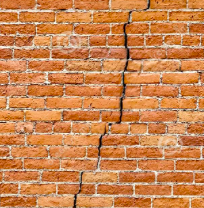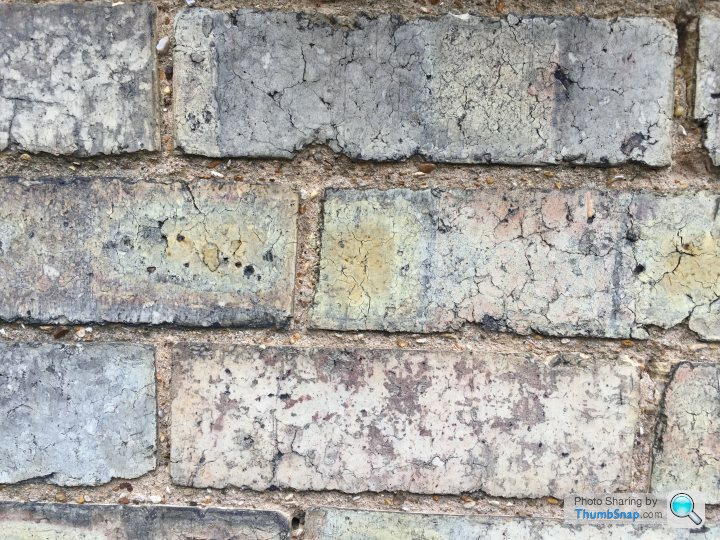Victorian semi - wall cracks serious?
Discussion
philv said:
CambsBill said:
I'm no expert but I thought the rule of thumb was that cracks in the mortar are usually indicative of minor settlement whereas cracks running through the bricks themselves is much more worrisome.
Also, that repointing looks like it's been done with cement rather than lime mortar (which was probably used in the original build). Cement can cause spalling of the bricks when it's wet & frosty as it's not sacrificial like lime is. If I was buying I'd look to repoint again with lime - actually easier to work with than cement as it doesn't go off anything like as quickly.
Apparently the bricks have lots of tiny cracks.Also, that repointing looks like it's been done with cement rather than lime mortar (which was probably used in the original build). Cement can cause spalling of the bricks when it's wet & frosty as it's not sacrificial like lime is. If I was buying I'd look to repoint again with lime - actually easier to work with than cement as it doesn't go off anything like as quickly.
Is that what you are referring to?
Yes, it is cement i think.
Edited by philv on Sunday 28th February 19:55

Micro-cracks in individual bricks are nothing to worry about & are probably there when the house was built. I just went outside to take this pic.

philv said:
Agreed.
If going by m2 alone it should be 300k, in comparison to the refurbished one.
Though no doubt, it is more complicated than that.
I would be surprised it sells at the asking range.
My problem is that we are against it time wise.
I am worried about having an offer offer accepted and then the bank refusing the mortgage because of the wall issues a month or so down the line.
From the pictures, I doubt being rejected because of the cracking. It will need further investigations. If going by m2 alone it should be 300k, in comparison to the refurbished one.
Though no doubt, it is more complicated than that.
I would be surprised it sells at the asking range.
My problem is that we are against it time wise.
I am worried about having an offer offer accepted and then the bank refusing the mortgage because of the wall issues a month or so down the line.
It may be down valued though, and given that you already see a lack of value in the property compared to others, I'd say that's quite likely. What LTV are you aiming for?
philv said:
Is a part concrete floor normal?
The last Victorian place I owned had suspended timber floors in the front room and hallway, with solid floors at the back of the house. They were basically large stone flags sitting directly on earth. When we bought the place, the rooms with solid floors had damp in the walls but once a chemical DPC had been injected the damp disappeared. I don’t know whether the floor construction contributed to the damp but the rooms with suspended timber floors had no damp.
01WE01 said:
philv said:
Agreed.
If going by m2 alone it should be 300k, in comparison to the refurbished one.
Though no doubt, it is more complicated than that.
I would be surprised it sells at the asking range.
My problem is that we are against it time wise.
I am worried about having an offer offer accepted and then the bank refusing the mortgage because of the wall issues a month or so down the line.
From the pictures, I doubt being rejected because of the cracking. It will need further investigations. If going by m2 alone it should be 300k, in comparison to the refurbished one.
Though no doubt, it is more complicated than that.
I would be surprised it sells at the asking range.
My problem is that we are against it time wise.
I am worried about having an offer offer accepted and then the bank refusing the mortgage because of the wall issues a month or so down the line.
It may be down valued though, and given that you already see a lack of value in the property compared to others, I'd say that's quite likely. What LTV are you aiming for?
So if down-valued it could be higher.
A good case for property seller packs.
I seller paying for a survey better than multiple buyers surely.
Thanks for all the replys.
I love the house, but can'y but it as i think it would take too long, etc.
It looks to me like three separate issues. Firstly there is evidence of historic or largely historic movement. Given that some of the repointing has opened up again, it should be investigated but may well not be serious.
Secondly you have localised settlement in the area where new common bricks have been let into the wall. It should be investigated more but it’s very possible that the creation of the aperture that the new bricks now fill caused localised movement
Thirdly, the original pointing is decaying and, if you buy the property, you should consider raking all of it out on the gable end wall and repointing.
Suspended timber to the front of a Victorian terrace and solid floors to the rear are perfectly common
Secondly you have localised settlement in the area where new common bricks have been let into the wall. It should be investigated more but it’s very possible that the creation of the aperture that the new bricks now fill caused localised movement
Thirdly, the original pointing is decaying and, if you buy the property, you should consider raking all of it out on the gable end wall and repointing.
Suspended timber to the front of a Victorian terrace and solid floors to the rear are perfectly common
Gassing Station | Homes, Gardens and DIY | Top of Page | What's New | My Stuff



